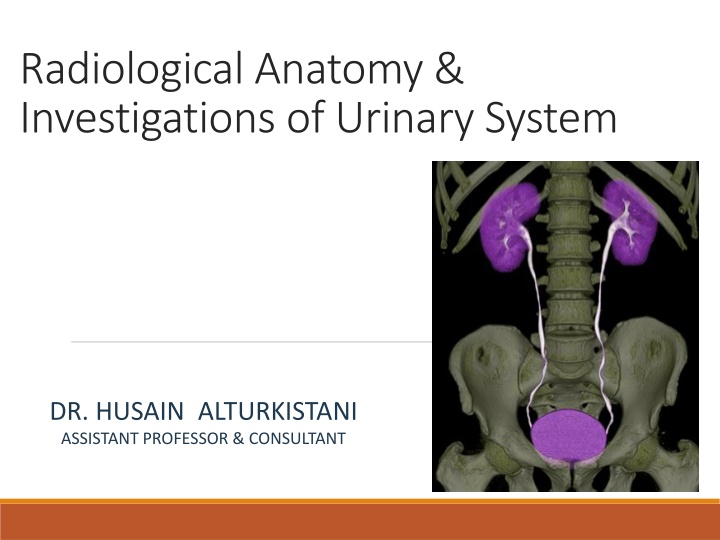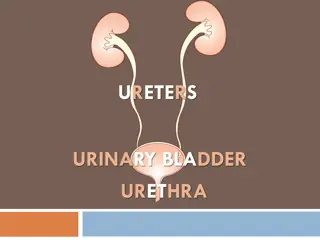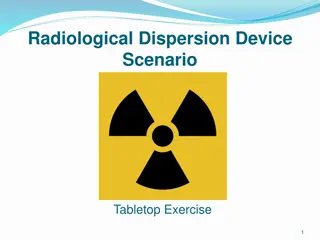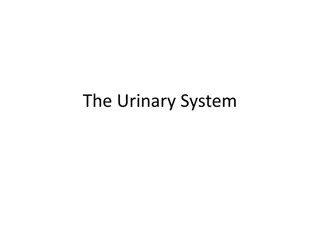Radiological Anatomy & Investigations of Urinary System by Dr. Husain Alturkistani
This educational resource delves into various imaging modalities used to visualize the urinary system, detailing the anatomy, sizes, and locations of structures like the kidneys, ureters, bladder, and urethra. It covers modalities such as plain X-ray, IVU, ultrasound, CT, MRI, and nuclear medicine, offering insights into their features and applications for assessing conditions like stones, hydronephrosis, and tumors.
Download Presentation

Please find below an Image/Link to download the presentation.
The content on the website is provided AS IS for your information and personal use only. It may not be sold, licensed, or shared on other websites without obtaining consent from the author.If you encounter any issues during the download, it is possible that the publisher has removed the file from their server.
You are allowed to download the files provided on this website for personal or commercial use, subject to the condition that they are used lawfully. All files are the property of their respective owners.
The content on the website is provided AS IS for your information and personal use only. It may not be sold, licensed, or shared on other websites without obtaining consent from the author.
E N D
Presentation Transcript
Radiological Anatomy & Investigations of Urinary System DR. HUSAIN ALTURKISTANI ASSISTANT PROFESSOR & CONSULTANT
Objectives To know the different types of modalities used in imaging the urinary tract To know the anatomic location and sizes of the structures of the urinary tract To identify the kidneys, ureters, urinary bladder and urethra on different imaging modalities
Urinary System Kidneys Ureters Urinary bladder Urethra
Imaging Modalities Imaging Modalities Plain X-Ray Intravenous Urogram (IVU) US CT MRI Nuclear medicine
Plain X-Ray First imaging modality Cheap Useful for radio-opaque stones
Image features: Projectional image Image contrast determined by tissue density Good evaluation radio-opaque stones
IVU Conventional x-ray + IV contrast Cheap Recently replaced by CT and MRI Useful for radio-opaque stones
Image features: Projectional image Image contrast determined by tissue density and IV contrast Good evaluation of collecting system and radio-opaque stones
US Use high frequency sound waves Contrast between tissue is determined by sound reflection.
Image features: Operator dependant Projectional image Good resolution Used for stones, hydronephrosis, and focal lesions
CT Same basic principle of radiography More precise Costly +/- contrast Useful for trauma, stone, tumor and infection
Image features: Cross sectional images Image contrast determined by tissue density +/- contrast Better evaluation of soft tissue
MRI Better evaluation of soft tissue Expensive Useful for soft tissue pathology: tumor, infection
Image features: Cross sectional images Image contrast determined by tissue properties Excellent for soft tissue evaluation
Nuclear medicine Utilizes a gamma camera and radioactive isotopes Functional test Less expensive Useful for: obstruction and split function
Image features: Projectional image Image contrast by tissue uptake and metabolism
Anatomy Anatomy
Kidneys Bean shaped structure On either side of the lower thoracic and upper lumbar spine Usual location between (T11-L3)
Kidneys are retroperitoneal organs and may be obscured by bowel loops
Kidneys Right kidney is 2 cm lower than the left kidney Long axis of the kidneys is directed downward and outward, parallel to the lateral border of the psoas muscles Lower pole is 2-3 cm anterior to the upper pole
MRI showing Left Kidney is higher than Right Kidney
CT Scan showing left kidney higher than right
Long axis of the kidneys is directed downward and outward, parallel to the lateral border of the psoas muscles
Kidneys Normal size : in adults 11-12 cm
Ultrasound is the best method to measure the size of the Kidney
Kidneys Kidneys are visualized on the X-Ray due to presence of perirenal fat They are contained within the renal capsule and surrounded by perirenal fat and enclosed within the Gerota s fascia Perirenal hemorrhage, pus and urine are contained within the fascia and detected on CT and US
ULTRASOUND OF KIDNEYS NORMAL STUDY DILATED RENAL PELVIS
Renal Vasculature Renal Vasculature
Renal Vasculature Renal arteries branch from the abdominal aorta laterally between L1 and L2, below the origin of the superior mesenteric artery The right renal artery passes posterior to the IVC There may be more than one renal artery (on one or both sides) in 20-30% cases
Renal Vasculature Renal veins drain into inferior vena cava Renal veins lie anterior to the arteries Left renal vein is longer and passes anterior to the aorta before draining into the inferior vena cava The left gonadal vein will drain into to left renal vein while the right gonadal vein drains directly into the inferior vena cava
RENAL ANGIOGRAPHY NORMAL SUPPLY OF BOTH KIDNEYS BY SINGLE RENAL ARTERY LEFT KIDNEY SUPPLIED BY TWO RENAL ARTERIES
Left Renal Vein Passes Anterior to the Abdominal Aorta
Renal Veins Lie Anterior to the Arteries
Relationships of the Kidneys Relationships of the Kidneys
Adrenal Glands are superior to the Kidneys
Renal Structure Cortex Renal cortex consists of glomeruli and renal tubules Normal thickness is 2.5 cm Medulla Consists of multiple renal pyramids























